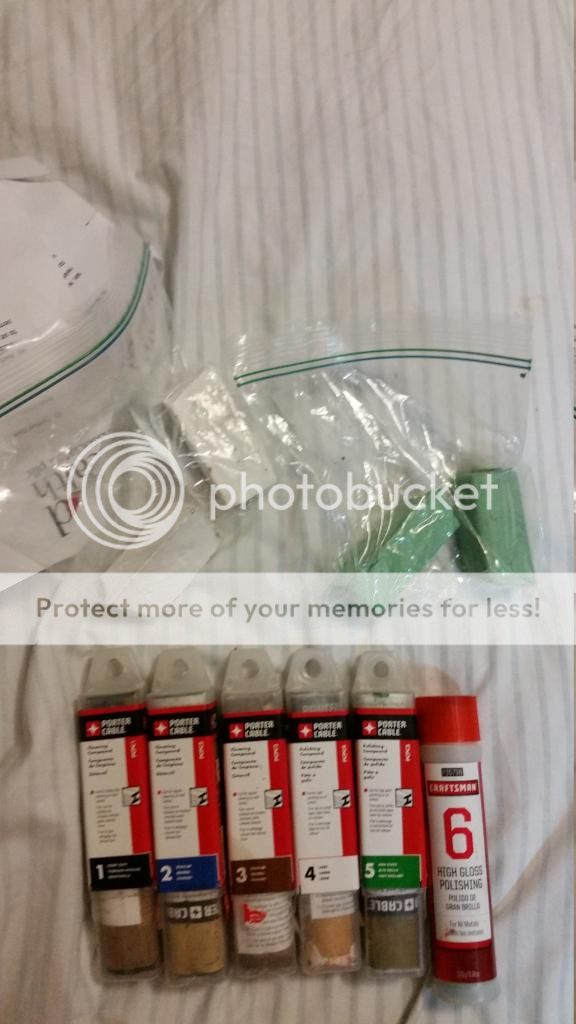AFAustin
Gold Member
- Joined
- Jun 8, 2004
- Messages
- 2,479
I enjoy trying new things to improve my sharpening results, and it got my attention when David (Obsessed with Edges) described the great results he gets when finishing with Ryobi "H" white rouge compound. He said he had bought it some time ago at Home Depot, and alas, it appears that HD now carries a different flavor, Ryobi "E", rather than the "H". I did manage to find some of the "H" on the well known auction site and bought it. I've only just begun to play with it, but my early results have been encouraging, especially on a small wooden paint stick strop covered with a single layer of denim (my results with paper on wood haven't been as good, but that could easily be due to imperfect technique).
As I searched around for the apparently discontinued Ryobi "H", I came across several more letter varieties, all packaged in the same 4 oz. red/blue/black/white/yellow plastic cylinders, as such:

I decided to try to put together a list of the different ones, along with their product numbers and micron particle size. I started by contacting Ryobi for the information, but got a very general reply:
Andrew,
The only information available on the compounds is listed below.
E is a stainless steel buffing compound for cleaning hard metals such as nickel and chrome, and shining soft metals as steel, brass, and copper.
F is a plastic rouge buffing compound for cleaning soft metals and plastic.
G is a jewelers rouge buffing compound for gold, silver, and platinum.
H is a white rouge buffing compound used for hard/soft metals, chrome, and plastic.
I wrote back to see if they could provide product #s and micron size. Their reply simply said:
I apologize for the delay. I was waiting for a response on the issue. The items were produced by a vendor that we no longer use. Unfortunately we do not have that information available.
So, since the horse's mouth wasn't yielding much, I spent a few minutes on the web and this is what I cobbled together, combined with the descriptions above:
"C": 1-3 micron. #AO1AG11. Emery buffing compound for coarse buffing.
"E": 4-7 micron. #A01AG15. Stainless steel buffing compound for cleaning hard metals such as nickel and chrome, and shining soft metals as steel, brass, and copper.
"F": 6-10 micron. #A01AG16. Plastic rouge buffing compound for cleaning soft metals and plastic.
"G": 6-10 micron. #A01AG17. Jewelers rouge buffing compound for gold, silver, and platinum.
"H": 2-5 micron. #A01AG09. White rouge buffing compound used for hard/soft metals, chrome, and plastic.
Hope this is of some help to anyone trying to sort out the Ryobi alphabet soup. And if I have anything wrong, or anyone has further info. or additions, please post them.
Andrew
As I searched around for the apparently discontinued Ryobi "H", I came across several more letter varieties, all packaged in the same 4 oz. red/blue/black/white/yellow plastic cylinders, as such:

I decided to try to put together a list of the different ones, along with their product numbers and micron particle size. I started by contacting Ryobi for the information, but got a very general reply:
Andrew,
The only information available on the compounds is listed below.
E is a stainless steel buffing compound for cleaning hard metals such as nickel and chrome, and shining soft metals as steel, brass, and copper.
F is a plastic rouge buffing compound for cleaning soft metals and plastic.
G is a jewelers rouge buffing compound for gold, silver, and platinum.
H is a white rouge buffing compound used for hard/soft metals, chrome, and plastic.
I wrote back to see if they could provide product #s and micron size. Their reply simply said:
I apologize for the delay. I was waiting for a response on the issue. The items were produced by a vendor that we no longer use. Unfortunately we do not have that information available.
So, since the horse's mouth wasn't yielding much, I spent a few minutes on the web and this is what I cobbled together, combined with the descriptions above:
"C": 1-3 micron. #AO1AG11. Emery buffing compound for coarse buffing.
"E": 4-7 micron. #A01AG15. Stainless steel buffing compound for cleaning hard metals such as nickel and chrome, and shining soft metals as steel, brass, and copper.
"F": 6-10 micron. #A01AG16. Plastic rouge buffing compound for cleaning soft metals and plastic.
"G": 6-10 micron. #A01AG17. Jewelers rouge buffing compound for gold, silver, and platinum.
"H": 2-5 micron. #A01AG09. White rouge buffing compound used for hard/soft metals, chrome, and plastic.
Hope this is of some help to anyone trying to sort out the Ryobi alphabet soup. And if I have anything wrong, or anyone has further info. or additions, please post them.
Andrew



